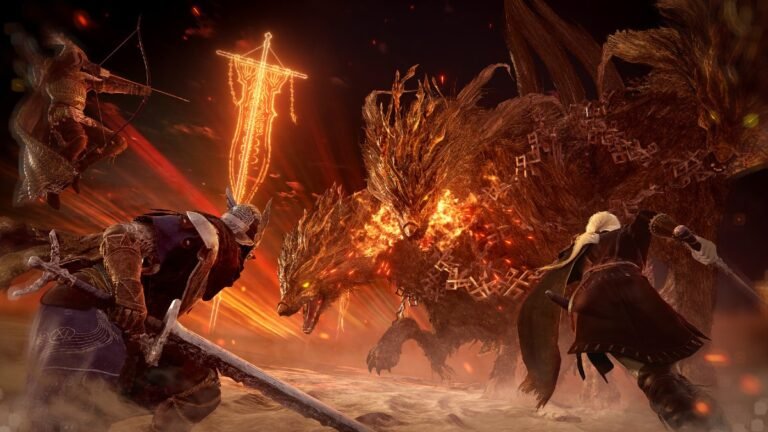That Elden Ring Nightreign works at all feels somewhat miraculous.
A full-on co-op experience carved from the hearty flesh of Elden Ring itself, Elden Ring Nightreign keeps some of the underlying structures, but welds them to mechanics and formulas found in Battle Royale games and Monster Hunter. If it weren’t FromSoftware behind it, I’d have been a lot more cynical about Nightreign’s existence with that in mind. Even then, playing Nightreign only reinforces how many online boxes it’s trying to tick. Still, if we can accept that from the rest of the industry, it’s only fair that FromSoftware gets a crack at box-ticking.
And while the parts don’t exactly blend together seamlessly, they do make an interesting whole.
It’s a refreshing throwback in a sense. A standalone spin-off that resues an established game’s assets to experiment with some fresh ideas. In this case, the largely solo sprawl of The Lands Between is reduced to restricted, yet sizable enough, chunks. And an encroaching deadly night storm turns up to further reduce your play area.
You join two other players in a game and are dropped into the world with a host of options, but limited time before the night storm shows up and funnels you to a particular part of the map. When that happens, a day-ending boss battle begins. Lose, and it’s game over. Succeed, and it’s onto Day 2 for more of the same.
The cycle is three days. The first and second stick to the regular map chunk, but on the third day, you’re transported to an otherworldly place for the climactic battle against one of the game’s Nightlords. Beat that, and you can head back to the Roundtable (now your central hub between expeditions) to spend your winnings and update your character’s skills with ability-boosting Relics you’ve picked up along the way. The average run takes about an hour, depending on your success/teammates.
Interestingly, the traditional leveling you do at Sites of Grace only ever applies to the session you’re in, so you start from zero each time, scrambling to add to your inventory as you race towards the big boss fight. This means you need to find ways to level up quickly, and around the map are various other bosses to tackle and earn runes from, and particular locales will hold valuable items to aid your quest. Of course, the storm starts to restrict where you can go and how much time you can viably spend battling enemies, so there’s a lot of on-the-fly decision-making that feeds into the overall urgency of Nightreign.
Elden Ring Nightreign Review: Night Shift
Sometimes, this creates exciting outcomes where you end up having to battle against the odds as much as the Nightlords. In most cases, there’s a way to mitigate your disadvantages, but when things go wrong, usually due to poor communication, a session can feel like a waste of time. But just quitting is discouraged, so you need to take the hit and see what good you can wring out of a bad situation.
The system is set up to encourage players to stick out the session, so that’s commendable, but the perils of playing with random players are high in Elden Ring Nightreign, and you really are best off having friends and game chat to plot your course properly.
Additionally, it enhances character synergy. Instead of a bare-bones starter character, you choose from a selection of pre-built ones with distinct abilities, strengths, and weaknesses. The key to success in Elden Ring Nightreign is complimenting each other’s skillsets. Sure, you can get so far without worrying about working together, but it almost always ends the same way.
What I do like about Nightreign’s setup is that I felt more comfortable trying character classes outside of those I used in Elden Ring. There’s no catch-all winning build to head out with, and like in other class-based co-op games, pairing the right skillsets together for the right opponent is far more crucial than playing comfy favorites.
I wasn’t sure this structure and pace would be to my admittedly cautious playstyle in FromSoftware games (Sekiro being the exception), but I ended up taking to Nightreign like a duck to water. I think it’s mostly because it keeps me out of my own head and forces me to push on. That was the nicest surprise of this experimental mix. I’m curious how that bleeds into my time with more traditional action RPGs going forward.
Also of note for long-time FromSoftware fans is that there are lots of nods to other games in its library, especially in the bosses you face. There were a couple of times I was reunited with a memorable foe from Dark Souls 3 that left me with a wide grin. The downside is that not every boss fits in their new location as smoothly as they did in the old ones, so there’s a slight disappointment mixed in there sometimes. Conversely, there are some nice challenges in these remixes.
The difficulty curve in FromSoftware games has always been an interesting aspect of their output, and the games that perhaps don’t fare as well are the ones that wildly fluctuate in terms of balance. Elden Ring Nightreign’s semi-random nature means you can potentially get a cakewalk one minute and a relentlessly punishing ordeal the next with no normal flow from one to the other. There’s an element of potluck to it that does ease slightly as you get used to the Frankenstein’s monster of assembled parts, but the consequence of that is I ended up feeling a little underwhelmed by several encounters that were supposed to be a challenge.
FromSoftware has transformed an epic journey into a relatively short hike, and when it works, it’s an accomplishment worth celebrating. But be warned, its experimental nature causes its fair share of issues.
Score 7/10 – Good
Developer: FromSoftware
Publisher: Bandai Namco
Reviewed on: PS5
Elden Ring Nightreign copy was purchased by the review author.
Elden Ring Nightreign is out now on PS4, PS5, Xbox One, Series X|S, and PC.

